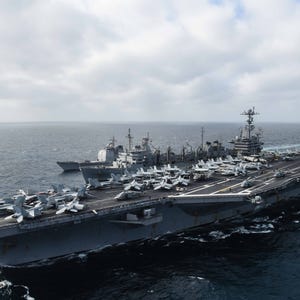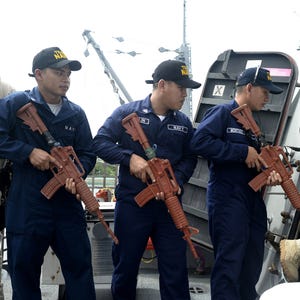An arbitration court ruled on Tuesday that China has no historic title over the waters of the South China Sea and has breached the Philippines' sovereign rights with its actions, infuriating Beijing which dismissed the case as a farce.
A defiant China, which boycotted the hearings at the Permanent Court of Arbitration in The Hague, vowed again to ignore the ruling and said its armed forces would defend its sovereignty and maritime interests.
China's state-run Xinhua news agency said shortly before the ruling was announced that a Chinese civilian aircraft had successfully tested two new airports in the disputed Spratly Islands.
And China's Defence Ministry said a new guided missile destroyer was formally commissioned at a naval base on the southern island province of Hainan, which has responsibility for the South China Sea.
"This award represents a devastating legal blow to China's jurisdictional claims in the South China Sea," Ian Storey, of Singapore's ISEAS Yusof Ishak Institute, told Reuters.
"China will respond with fury, certainly in terms of rhetoric and possibly through more aggressive actions at sea."
The United States, which China has accused of fuelling tensions and militarizing the region with patrols and exercises, said the ruling should be treated as final and binding.
"We certainly would urge all parties not to use this as an opportunity to engage in escalatory or provocative action," White House spokesman Josh Earnest told reporters in a briefing.
U.S. officials have previously said they feared China may respond to the ruling by declaring an air defense identification zone in the South China Sea, as it did in the East China Sea in 2013, or by stepping up its building and fortification of artificial islands.
China claims most of the energy-rich waters through which about $5 trillion in ship-borne trade passes every year. Brunei, Malaysia, the Philippines, Taiwan and Vietnam also have claims.
Finding for the Philippines on a number of issues, the panel said there was no legal basis for China to claim historic rights to resources within its so-called nine-dash line, which covers almost 90 percent of the South China Sea.
It said China had interfered with traditional Philippine fishing rights at Scarborough Shoal and had breached the Philippines' sovereign rights by exploring for oil and gas near the Reed Bank.
None of China's reefs and holdings in the Spratly Islands entitled it to a 200-mile exclusive economic zone, it added.
United Nations Secretary-General Ban Ki-moon called on all parties to resolve the disputes in a "peaceful and amicable manner through dialogue and in conformity with international law."
"2,000 YEARS OF HISTORY"
China's Foreign Ministry rejected the ruling, saying its people had more than 2,000 years of history in the South China Sea, that its islands did have exclusive economic zones and that it had announced to the world its "dotted line" map in 1948.
"China's territorial sovereignty and maritime rights and interests in the South China Sea shall under no circumstances be affected by those awards," it said.
However, the ministry also repeated that China respected and upheld the freedom of navigation and overflight and that China was ready to keep resolving the disputes peacefully through talks with states directly concerned.
Julia Guifang Xue, a professor of international law at Shanghai Jiao Tong University, speaking at the Center for Strategic and International Studies in Washington, said that given Beijing's sensitivity about sovereignty and security "we won't be surprised to see some kind of renewed effort by China to consolidate its claim in the area."
In a statement shortly before the ruling, China's Defence Ministry said its armed forces would "firmly safeguard national sovereignty, security and maritime interests and rights, firmly uphold regional peace and stability, and deal with all kinds of threats and challenges"
The judges acknowledged China's refusal to participate, but said they sought to take account of China's position from its statements and diplomatic correspondence.
"The award is a complete and total victory for the Philippines ... a victory for international law and international relations," said Paul Reichler, lead lawyer for the Philippines.
Vietnam said it welcomed the ruling.
Taiwan, which maintains that the island it occupies, Itu Aba, is legally the only island among hundreds of reefs, shoals and atolls scattered across the seas, said it did not accept the ruling, which seriously impaired Taiwan's territorial rights.
"This is the worst scenario," Taiwan Foreign Minister David Tawei Lee told reporters, promising unspecified "action" from Taipei.
GROUND-BREAKING RULING
The ruling is significant as it is the first time that a legal challenge has been brought in the dispute, which covers some of the world's most promising oil and gas fields and vital fishing grounds. [
bit.ly/29AlvXc]
It reflects the shifting balance of power in the 3.5 million sq km sea, where China has been expanding its presence by building artificial islands and dispatching patrol boats that keep Philippine fishing vessels away.
Andrew Mertha, a China specialist at Cornell University in the United States, said the ruling further isolated China internationally.
"Domestically, Beijing has painted itself into a corner and may find itself compelled to act in a potentially reckless fashion, if only to demonstrate to its domestic audience that it is not ... an 'empty cannon' in the eyes of its own citizens."
The Philippines said it was studying the ruling.
"We call on all those concerned to exercise restraint and sobriety," Foreign Affairs Secretary Perfecto Yasay told a news conference. "The Philippines strongly affirms its respect for this milestone decision as an important contribution to the ongoing efforts in addressing disputes in the South China Sea."
Japan said the ruling was legally binding and final.
The court has no power of enforcement, but a victory for the Philippines could spur Taiwan, Vietnam, Malaysia and Brunei to file similar cases.
Ahead of the ruling, around 100 members of a Philippine nationalist group demonstrated outside the Chinese consulate in Manila, calling on Beijing to accept the decision and leave the Scarborough Shoal, a popular fishing zone off limits to Filipinos since 2012.
In China, social media users reacted with outrage at the ruling.
"It was ours in the past, is now and will remain so in the future," wrote one user on microblogging site Weibo. "Those who encroach on our China's territory will die no matter how far away they are."
Spreading fast on social media in the Philippines was the use of the term "Chexit" - the public's desire for Chinese vessels to leave the waters.
(Additional reporting by Thomas Escritt in Amsterdam, Enrico Dela Cruz and Martin Petty in Manila, Megha Rajagopalan in Beijing, Tim Kelly in Tokyo, John Walcott, David Brunnstrom and Jeff Mason in Washington, JR Wu in Taipei and Greg Torode in Hong Kong; Writing by Lincoln Feast and Nick Macfie; Editing by Mike Collett-White and Grant McCool)













No comments:
Post a Comment